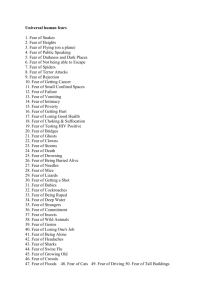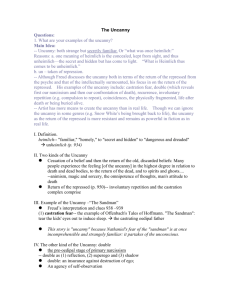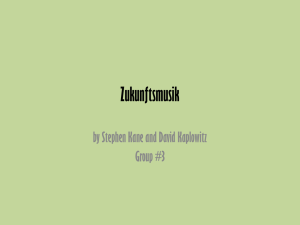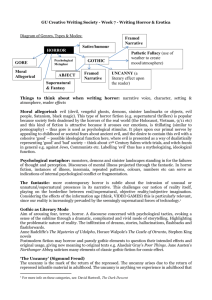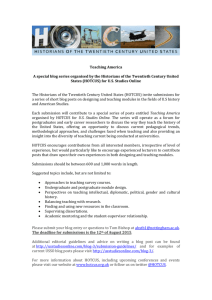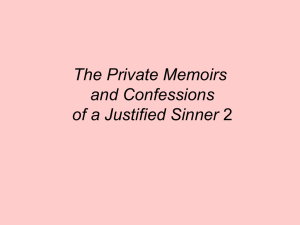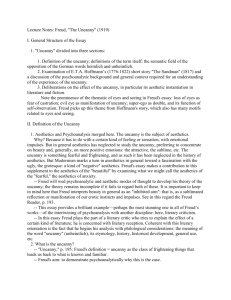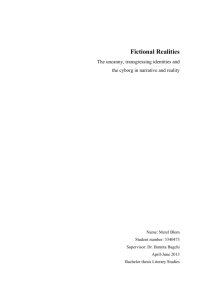LIT 292-IH2 - The Uncanny
advertisement
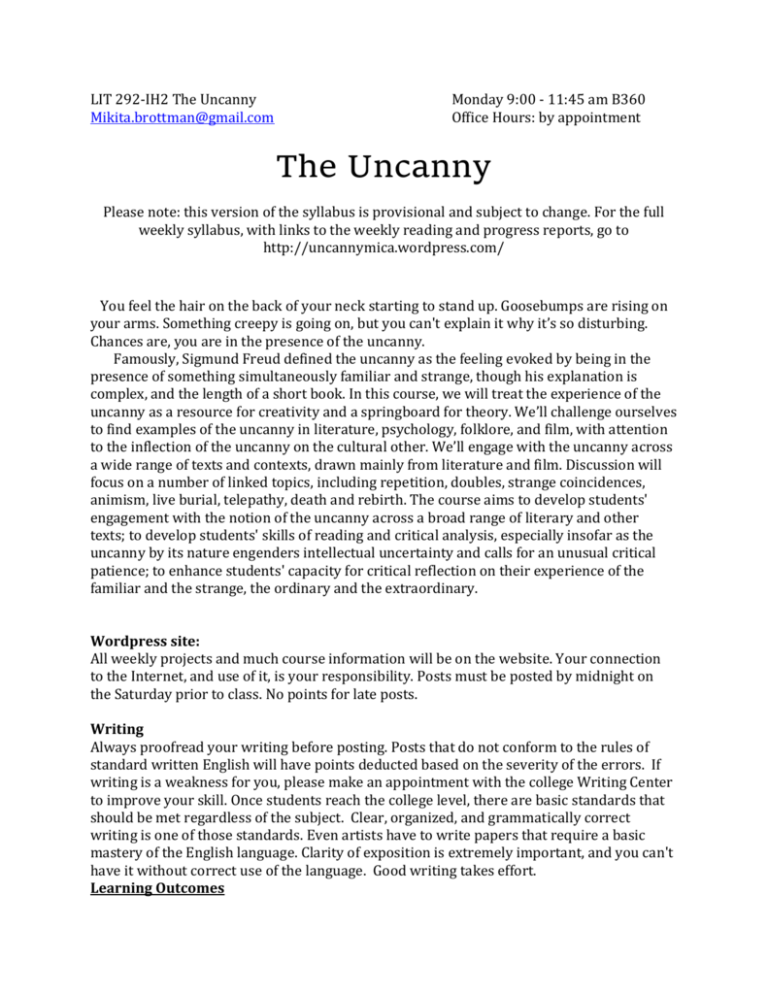
LIT 292-IH2 The Uncanny Mikita.brottman@gmail.com Monday 9:00 - 11:45 am B360 Office Hours: by appointment The Uncanny Please note: this version of the syllabus is provisional and subject to change. For the full weekly syllabus, with links to the weekly reading and progress reports, go to http://uncannymica.wordpress.com/ You feel the hair on the back of your neck starting to stand up. Goosebumps are rising on your arms. Something creepy is going on, but you can't explain it why it’s so disturbing. Chances are, you are in the presence of the uncanny. Famously, Sigmund Freud defined the uncanny as the feeling evoked by being in the presence of something simultaneously familiar and strange, though his explanation is complex, and the length of a short book. In this course, we will treat the experience of the uncanny as a resource for creativity and a springboard for theory. We’ll challenge ourselves to find examples of the uncanny in literature, psychology, folklore, and film, with attention to the inflection of the uncanny on the cultural other. We’ll engage with the uncanny across a wide range of texts and contexts, drawn mainly from literature and film. Discussion will focus on a number of linked topics, including repetition, doubles, strange coincidences, animism, live burial, telepathy, death and rebirth. The course aims to develop students' engagement with the notion of the uncanny across a broad range of literary and other texts; to develop students' skills of reading and critical analysis, especially insofar as the uncanny by its nature engenders intellectual uncertainty and calls for an unusual critical patience; to enhance students' capacity for critical reflection on their experience of the familiar and the strange, the ordinary and the extraordinary. Wordpress site: All weekly projects and much course information will be on the website. Your connection to the Internet, and use of it, is your responsibility. Posts must be posted by midnight on the Saturday prior to class. No points for late posts. Writing Always proofread your writing before posting. Posts that do not conform to the rules of standard written English will have points deducted based on the severity of the errors. If writing is a weakness for you, please make an appointment with the college Writing Center to improve your skill. Once students reach the college level, there are basic standards that should be met regardless of the subject. Clear, organized, and grammatically correct writing is one of those standards. Even artists have to write papers that require a basic mastery of the English language. Clarity of exposition is extremely important, and you can't have it without correct use of the language. Good writing takes effort. Learning Outcomes By completing this course, students will: (a) engage with the notion of the Uncanny across a broad range of texts; (b) develop skills in reading, writing and critical analysis; (c) learn to accept intellectual uncertainty and develop critical patience; (d) reflect critically on the familiar and the strange, the ordinary and the extraordinary. Grades 10 blog posts at 3 points each: 30 points. 2 multiple-choice quizzes, worth 20%. 1 presentation, worth 20% 1 final in-class long paper worth 30%. Class Expectations Please respect your fellow students by arriving for class on time, with your books and reading materials. There will be no need for laptops in class. Please: no texting, tweeting or use of electronic devices during class. Quizzes will begin right on time. If you arrive late, you’ll miss the quiz – do not ask for a make up. My dog Oliver will usually come to class. If he bothers you, please send me an e-mail and I’ll leave him in my office. Your Progress in this Course The blog has a page called “Check Your Progress.” I will update your score every week so you know exactly how many points you have at every stage of the course. There’s no reason why you should be surprised by your grade. Do not ask for make-up tests, posts or presentations. If you miss anything, you must deal with the consequences, as you would in any other situation Presentations: Feb 9, Feb 16, March 2, March 9, March 23, April 6, April 13, 20 27. 95-100=A+ 66-70=C+ 90-95=A 60-65=C 86-90=A- 56-60=C- 80-85=B+ 50-55=D+ 76-80=B 46-50=D REQUIRED READING Sigmund Freud, The Uncanny (London, Penguin) Other editions are acceptable. Weekly Syllabus (1) Mon Jan 26: Intro to the Course “In his essay on the uncanny, Das Unheimliche, Freud said that the uncanny is the only feeling which is more powerfully experienced in art than in life. If the genre required any justification, I should think this alone would serve as its credentials.” – Stanley Kubrick The Uncanny (Powerpoint) Lecture Notes This week’s reading: Intro to Freud, The Uncanny (ppvii-lx) Extract from Sir James Frazer The Golden Bough (1922) Draw lots for presentation dates. No blog post required this week (2) Monday Feb 2: The Sandman Read: Freud, The Uncanny part 1 (p123-134); E.T.A. Hoffmann, “The Sandman” (1816). (printable pdf version here: 20 pages: The Sandman). Class viewing: Rich Ragsdale, “The Sandman” (2007) Christina Bachler & Felix Metzler, “Nathanael” (2008); Tales of Hoffmann, Offenbach, doll song sung by Edita Gruberova, 1993. The Chordettes, Mr. Sandman. Blog post 1 (3) Wednesday Feb 9: Dolls, Dummies, Puppets & Dwarfs Dolls, dummies, puppets & dwarfs are all examples of the homunculus, or “little man”. Like humans, but not quite, they share aspects of our familiar world but inhabiting another, teasing our imaginations to enter the unfamiliar. Not all dolls or puppets share the uncanny; you know the difference when you see it. Gounod (1818-1893), Funeral March of a Marionette; Puppet Court from I Am Suzanne (1934); Ventriloquist Dummy Sequence, from Dead of Night (1945); Anthony Hopkins in Magic (1978); Terrifying Ventriloquists’ Dummies. This week’s reading: “The New Idols”, from Victoria Nelson, The Secret Lives of Puppets, Harvard University Press, 2001 (p60-66); Steve Speer, For Fear of Little Men “, in Adam Parfrey, ed., Apocalypse Culture II, LA: Feral House, 1987. Presentation: Blog post 2 (4) Monday February 16: Uncanny Places What makes a place Uncanny? Different places affect people in different ways. We don’t all feel the same way about particular places. What kind of place is Uncanny to you?Typically, these are abandoned hospitals, asylums, factories, amusement parks, ghost towns and so on. But they can be more banal and small scale than that. For example, here are five examples of uncanny rooms I found in a real estate blog. What makes them uncanny? Room one; room two; room three; room four; room five. ALSO: Death Sites, Sedlec Ossuary, Jan Svanjmajer (1970); Crypt of the Capuchins (Music: Camille Saint-Saens, “Danse Macabre”).Read: Sarah Burns, “Better For Haunts”, Victorian Houses and the Modern Imagination, American Art, Vol. 26, No. 3 (Fall 2012), pp. 2-25. Monoliths and Megaliths. Callanish. Worship of Pan. More Pan. Presentation: No blog post this week: prepare for quiz. (5) Monday Feb 23 Quiz on material covered so far. Movie, Roman Polanski, The Tenant (1976) Blog post 3 (6) Monday March 2: The Double Of the themes of uncanniness, Freud says: “These themes are all concerned with the idea of a “double” in every shape and degree, with persons, therefore, who are to be considered identical by reason of looking alike; Hoffman accentuates this relation by transferring mental processes from the one person to the other—what we should call telepathy—so that the one possesses knowledge feeling and experience in common with the other, identifies himself with another person, so that his self becomes confounded, of the foreign self is substituted for his own—in other words, by doubling, dividing and interchanging the self. And finally there is the constant recurrence of similar situations, a same face, of charactertrait, or twist of fortune, or a same crime, of even a same name recurring throughout several consecutive generations". Read: Truman Capote, “Miriam” (1945). Presentation: Blog post 4 (7) March 9: Ghosts & Spirits Freud believed ghosts of dead loved ones could be explained as “an opposition by the bereaved so intense that a turning away from reality takes place and a clinging to the object through the medium of hallucinatory wistful psychosis”. The fear of ghosts is widespread even in post-industrial societies. Philosopher Peter van Inwagen wrote: “…I am perfectly aware that the fear of ghosts is contrary to science, reason and religion. If I were sentenced to spend a night alone in a graveyard, <…> I should already know that twigs would snap and the wind moan and that there would be half-seen movements in the darkness. And yet, after I had been frog-marched into the graveyard, I should feel a thrill of fear every time one of these things happened…” In many traditional accounts, ghosts are often thought to be deceased people looking for vengeance, or imprisoned on earth for bad things they did during life. The appearance of a ghost has often been regarded as an omen or portent of death. Seeing one’s own ghostly double or doppelgänger is a related omen of death. Presentation: No blog post this week (8) March 16: Spring Break (9) Monday March 23: Uncanny Families All families are strange from the outside, but some families are positively Uncanny. Families are archives that record the traces of lives, sources of remembering and forgetting. And what is forgotten is as important as what is remembered. Sometimes what is forgotten can return. At other times, what is forgotten reappears in ghostly traces, a kind of pattern that weighs upon us across generations. Still other times, what is forgotten never could have been. This week’s reading: Lisa Tuttle, “Replacements” (pdf) (1992) Presentation: Blog post 5 (10) Monday March 30: Quiz & Movie Quiz on material covered in weeks 6-10 Movie: Herk Hervey, Carnival of Souls (1962) After a traumatic accident, a woman becomes drawn to a mysterious abandoned carnival. Blog post 6 (11) Monday April 6: Uncanny Bodies The human body is a strange and mysterious thing. Some people have extra fingers, some have to missing body parts, some have congenital tails and some have accidental deformities. From a certain perspective, however, even the "normal" human body is deeply uncanny. Clip: Teeth. This Week's Reading: Janice Galloway, “Blood” (1991) (pdf). Mark Dery, "Toe Fou" and "Open Wide", from I Must Not Think Bad Thoughts, U Minn Press 2013. Presentation Blog post 7 (10) Monday April 13: Uncanny Animals Animals have always been part of the creative imagination, and uncanny animals have emerged from the interaction of painters, printmakers, artisans, cartographers, and natural historians. All these practitioners carefully observed, pictured and cataloged exotic animals, and they also engaged in a joint, conjectural guesswork as to what other, as yet unknown animals might hide in the jungles and rivers of unknown places. Presentation Blog post 8 (11) Wednesday April 20: Uncanny Machines Machines can be uncanny, especially when they're ludicrously complicated, impractical or elaborate. We'll get into technology next week, but this week we'll be focusing on mechanical devices that have an element of the absurd, mysterious, fantastical or simply disgusting. Presentation Blog post 9 (12) Monday April 27: Presentation Blog post 10 (13) Monday May 4 Final In-Class Exam ADA Compliance Statement Any student who feels s/he may need an accommodation based on the impact of a disability should contact the instructor privately to discuss specific needs. Please contact the Learning Resource Center at 410-225-2416, in Bunting 458, to establish eligibility and coordinate reasonable accommodations. For additional information please refer to: http://www.mica.edu/LRC Health and Safety Compliance It is the responsibility of faculty and students to practice health and safety guidelines relevant to their individual activities, processes, and to review MICA's Emergency Action Plan and attend EHS training. It is each faculty member's responsibility to coordinate with the EHS Office to ensure that all risks associated with their class activities are identified and to assure that their respective classroom procedures mirror the EHS and Academic Department guidelines. Each of these policies and procedures must be followed by all students and faculty. Most importantly, faculty are to act in accordance with all safety compliance, state and federal, as employees of this college and are expected to act as examples of how to create art in a way to minimize risk, and reduce harm to themselves and the environment. Faculty must identify, within each art making process, and require personal protection equipment use, by each student for each class, when applicable. Students are required to purchase personal protection equipment appropriate to their major. Those students who do not have the proper personal protection equipment will not be permitted to attend class until safe measures and personal protection is in place.
